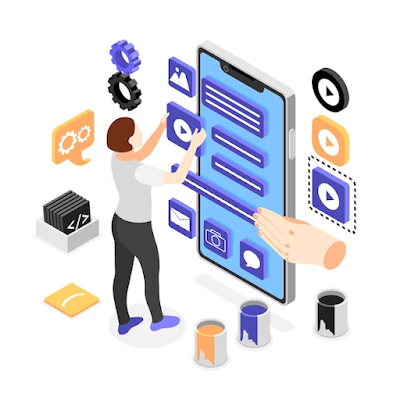In the ever-evolving landscape of mobile applications, Progressive Web App (PWA) development has emerged as a powerful and versatile solution. One specific area that has gained significant traction is PWA utility app development. This article will delve into the intricacies of building PWA utility apps, exploring the benefits, the development process, and why hiring a PWA developer is crucial for success.
Understanding PWA Utility Apps
What is a PWA Utility App?
A PWA utility app is designed to provide users with a seamless and engaging experience while performing specific tasks or accessing particular services. These apps leverage the principles of Progressive Web App development to combine the best features of both web and mobile applications. They are fast, reliable, and offer a user-friendly interface, making them ideal for various utility-driven purposes.
Key Features of PWA Utility Apps
Offline Functionality: PWA utility apps can function even in low or no network conditions, ensuring users can access essential features anytime, anywhere.
Responsive Design: These apps are built with a responsive design, ensuring a consistent and optimized user experience across various devices and screen sizes.
App-Like Experience: PWA utility apps mimic the feel and performance of native mobile apps, enhancing user engagement and satisfaction.
Push Notifications: Users can receive timely updates and notifications, enhancing the app's usability and keeping users informed about relevant information.
The PWA Development Process
1. Planning and Ideation
Before diving into development, a comprehensive plan and clear ideation are essential. Identify the specific utility your app will provide and define the features that will make it stand out. This stage is critical for creating a roadmap that guides the development process.
2. Designing the User Interface (UI/UX)
A well-designed user interface is crucial for the success of any app. For PWA utility apps, the focus should be on simplicity, intuitiveness, and responsiveness. Hire PWA developers with expertise in crafting user-centric designs that enhance the overall user experience.
3. Development
The actual development phase involves coding the app based on the planned features and design. Progressive web app development emphasizes using web technologies, making it accessible to a broader audience. Custom mobile app development skills come into play to ensure the app meets specific requirements.
4. Testing
Thorough testing is a non-negotiable step in the development process. Ensure the app functions seamlessly across different browsers and devices. Test its performance in various network conditions and validate the offline functionality to guarantee a reliable user experience.
5. Deployment
Once the app has successfully passed the testing phase, it's time to deploy it. PWA utility apps are easy to deploy since they don't require approval from app stores. Users can access and install the app directly from their web browsers.
The Importance of Hiring a PWA Developer
1. Expertise in Progressive Web App Development
Hire a PWA developer who brings specialized skills to the table. These professionals are well-versed in the nuances of PWA development, ensuring your utility app is built to the highest standards.
2. Custom Mobile App Development Skills
A PWA developer with experience in custom mobile app development can tailor the app to meet your unique requirements. This includes incorporating specific features, optimizing performance, and ensuring compatibility with various devices.
3. Faster Development Cycles
Proficient PWA developers can significantly shorten development cycles. This efficiency is critical in the fast-paced world of app development, allowing you to bring your utility app to market quicker and stay ahead of the competition.
4. Continuous Maintenance and Updates
Once your PWA utility app is live, ongoing maintenance and updates are essential. A dedicated PWA developer can ensure your app remains up-to-date, secure, and compatible with the latest technologies.
5. Seamless Integration of New Features
You may want to integrate new features or enhancements as your app evolves. Hiring a PWA developer ensures seamless integration, preventing disruptions to the user experience and maintaining the app's overall performance.
Why Choose PWA for Utility App Development
Progressive Web App development offers several advantages for utility apps, making it a preferred choice for many businesses.
Cost-Effective Development
PWA utility apps are cost-effective to develop compared to native mobile apps. They leverage web technologies, reducing the need for separate development teams for different platforms.
Broad Accessibility
Since PWA utility apps are web-based, users can access them from any device with a web browser. This broad accessibility enhances the app's reach and usability.
Offline Functionality
The offline functionality of PWA utility apps is a game-changer. Users can continue to use essential features even in areas with poor or no network connectivity, providing uninterrupted service.
App Store Independence
PWA utility apps do not rely on traditional app stores for distribution. This independence eliminates the need to adhere to strict app store guidelines and allows for direct deployment.
Faster Loading Speeds
PWAs are known for their fast loading speeds, contributing to a smooth and enjoyable user experience. This is crucial for utility apps where users expect quick access to the information or services they need.
Conclusion
In conclusion, PWA utility app development represents a cutting-edge approach to providing users with efficient and reliable solutions for various tasks. The unique blend of web and mobile app features, combined with the expertise of a skilled PWA developer, can result in a powerful and user-friendly application. As businesses continue to recognize the benefits of PWAs, the demand for custom mobile app development, specifically focused on utility, is expected to rise. Embrace the PWA revolution, hire a PWA developer, and unlock the full potential of your utility app in the digital landscape.

No comments:
Post a Comment